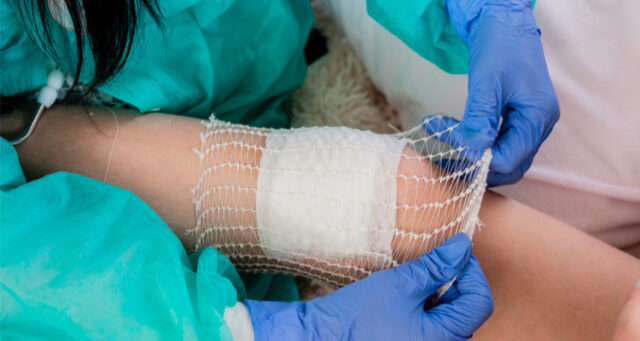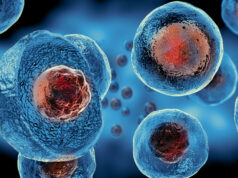
Xintela’s CEO sees potential in difficult-to-heal wounds
Difficult-to-heal wounds are a painful and costly problem that Xintela has chosen to address. This year, the company will start a phase I/II study with the stem cell product XSTEM in patients with difficult-to-heal leg ulcers. The market potential and medical needs in this area are extensive, says CEO Evy Lundgren-Åkerlund, whom BioStock has interviewed.
Xintela uses the stem cell marker integrin α10β1 to select and quality assure stem cells in the company’s stem cell products XSTEM, for the treatment of humans, and EQSTEM, for the treatment of horses.
Currently, the company is focusing on developing stem cell-based therapies for the treatment of osteoarthritis and difficult-to-heal leg ulcers. Xintela’s CEO Evy Lundgren-Åkerlund emphasises the medical need in difficult-to-heal wounds in a press release:
»Wound healing is an exciting indication for our stem cell product XSTEM. The medical need is very high and we see a large and attractive market in an area that consumes significant healthcare resources. We can quickly enter the market with a wound healing XSTEM product because clinical studies in wound healing can be completed in a relatively short time«
Difficult-to-heal leg ulcers lead to reduced quality of life and strain the health care system
Difficult-to-heal leg ulcers are usually defined as a wound below the knee that has not healed within 6 weeks. Besides causing the patient pain and suffering, these ulcers also result in significant costs and resource strain on the healthcare system.
In Sweden alone, the total treatment cost of difficult-to-heal leg ulcers amounts to 2 billion SEK per year, according to a report from SBU (The Swedish Agency for Health Technology Assessment and Assessment of Social Services). It is also a global problem – wound-related costs are estimated to account for 2-4 per cent of the total budget for health care in industrialised countries. In addition, costs are expected to rise due to an ageing population and an increased incidence of diabetes, which is a common underlying cause of severe leg ulcers.
Focusing on venous leg ulcers
Another common cause of difficult-to-heal wounds is venous insufficiency, i.e. impaired blood circulation in the veins. Venous insufficiency occurs mainly in the legs, which can cause so-called venous leg ulcers. The risk of suffering from venous leg ulcers increases with age and is, therefore, a common problem in elderly care. In the EU alone, between 490,000 and 1.3 million people suffer from venous leg ulcers, where the elderly population is highly overrepresented. About 4 per cent of the population over the age of 65 suffers from venous leg ulcers.
Since venous leg ulcers make up a large portion of difficult-to-heal leg ulcers, about 50-70 per cent, Xintela has chosen to focus primarily on this type of wounds.
Growing market but the need for new treatments remains
According to Fortune Business Insights, the global chronic wound care market was valued at 10.12 BUSD in 2019.The market value is expected to increase to 16.36 BUSD by 2027, with a CAGR of 6.2 per cent.
Today’s treatments for difficult-to-heal wounds include wound dressings and compression treatment to reduce swelling. Some surgical procedures can also be used, e.g. covering the wound with healthy skin cells that are either taken from another body area or that are laboratory grown. Some mild medications can be given after compressiontherapy or surgery, but they only provide symptomatic relief. Current treatment methods have proven insufficient and there is, therefore, a great need for better and more effective alternatives. In addition, it is worth noting that there is a complete lack of biological drugs, including cell therapies, for this patient group.
Xintela’s stem cell therapy breaks new ground
Using stem cells to heal difficult-to-heal wounds has been tested in several studies, including under the auspices of Xintela. Together with Professor Folke Sjöberg and his colleagues at the Burn Center at Linköping University Hospital, Xintela has shown that the stem cell treatment XSTEM has excellent wound healing ability in a preclinical wound model and that the newly formed skin tissue is similar to normal skin.
It is, among other things, the stem cells’ immunomodulatory properties and ability to develop into skin cells that are believed to have a beneficial effect on wound healing. Read more about XSTEM’s characteristics in the interview below.
Phase I/IIa study to evaluate safety and effect
Xintela is planning a clinical study on patients together with the Linköping team. The ambition is to initiate a clinicalphase I/IIa study with XSTEM in patients with difficult-to-heal leg ulcers in mid-2022. In the study, XSTEM will be applied to the wound after which the patient will be followed for a 10 week period to evaluate safety and efficacy. Upon positive results, Xintela plans to broaden its use for the treatment to include burns and other skin defects.
The study is partly financed by a grant of SEK 4.8 million from Vinnova, Sweden’s innovation agency.

Xintela’s CEO on the development plans
BioStock spoke to Xintela’s CEO Evy Lundgren-Åkerlund about their development plans and why stem cell therapy is an interesting area to explore in the context of difficult-to-heal wounds.
What is the status of the project
–We have submitted an application to the Medical Products Agency for approval to start the clinical study, the stem cells are produced and we plan to get started with the study after the summer.
Could you expand on the problems that difficult-to-heal leg ulcers are associated with?
– Severe leg ulcers are a major problem, especially for the affected patient, due to pain, restrictions on physical activity, isolation and increased care dependency. A significant portion of affected patients suffer from their difficult-to-heal wounds for years, which makes them feel hopeless and do not expect new and repeated treatments to help. A product that clearly improves wound healing for these patients would significantly improve their quality of life, while also greatly reducing healthcare costs linked to the problem of difficult-to-heal wounds.
How is XSTEM positioned in the market for treatments of difficult-to-heal venous leg ulcers?
– XSTEM is in a very strong position as preclinical trials have already shown that our product has clear wound healing properties. Current treatments for difficult-to-heal leg ulcers are often expensive, time-consuming and ineffective, and over 50 per cent of all difficult-to-heal wounds do not respond to current treatment options. As there are no effective alternatives available, the field is moving towards new promising areas such as cell therapy. In addition, the competition is also very limited, which makes the area even more attractive to Xintela and XSTEM.
»XSTEM is in a very strong position as preclinical trials have already shown that our product has clear wound healing properties«
What are the properties of the mesenchymal stem cells in XSTEM that make them have wound healing potential?
– The stem cells that we produce from donated adipose tissue and purify through integrin a10b1 selection, have several functional properties. First of all, they secrete various factors such as immunomodulatory cytokines and growth factors that have a positive effect on the cells in the skin around the wound area, which also has an anti-inflammatory effect. The stem cells also have the ability to be converted into other cells, and are expected to directly contribute to wound healing by converting into the type of cells that are normally found in the skin and thus regenerate (build) new skin tissue.
What effect do you hope that XSTEM will have in the phase I/IIa clinical trial in patients with difficult-to-heal wounds?
– Firstly, the primary objective of the study is to show that XSTEM is a safe treatment for this patient group. The secondary objective is to show that XSTEM is an effective treatment in terms of wound healing and pain reduction.
You have communicated that you can reach the market relatively quickly with XSTEM for the treatment of difficult-to-heal wounds. Could you explain what makes this possible?
– That is right, difficult-to-heal wounds is an interesting indication, with relatively short clinical studies, which means that the time to market can be comparatively short.
The content of BioStock’s news and analyses is independent but the work of BioStock is to a certain degree financed by life science companies. The above article concerns a company from which BioStock has received financing.»Difficult-to-heal wounds is an interesting indication, with relatively short clinical studies, which means that the time to market can be comparatively short«


